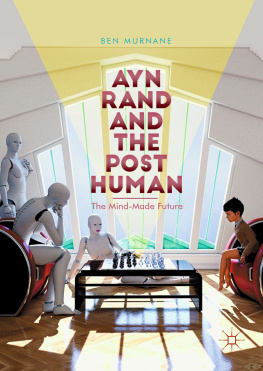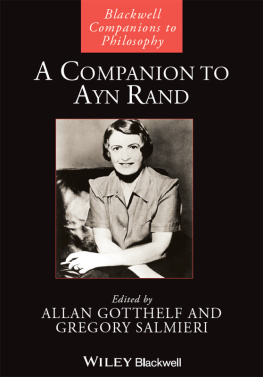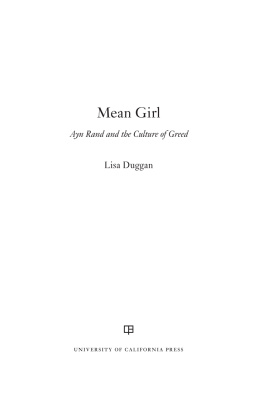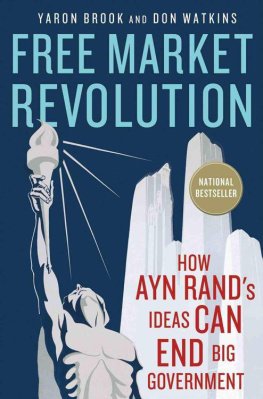1. Introduction: A Posthuman Objective
Ayn Rand is one of the most divisive icons in Americas divided cultural and political landscape. Ask a politically interested person from the United States what he or she thinks of Ayn Rand, and you will discover where on the ideological spectrum they sit. The Russian-American novelist and philosopher is fted on the right for her exposition of what she called the morality of capitalism, while on the left she is vilified and satirized for the same.
Rand, born in St Petersburg in 1905, immigrated to the United States at the age of 21, and went on to write four novels, plus a series of nonfiction books. Rands fiction is a vessel for the delivery of her theories, and her nonfiction references her fiction to demonstrate its points. Rand developed a philosophy she called Objectivism, which holds that reality is fixed outside of us, objective, and knowable through investigation. Objectivism venerates productivity: the turning of the physical material of the world into products useful for humanity. The role of the human mind is to transform physical reality. Rands celebration of productivity, and her belief that every person is an end in themselvesher individualismmade her a major supporter of capitalism, and thus a celebrant of America, at the height of the Cold War.
For a body of work developed over some half a century, between the 1920s and 1970s, Rands corpus is remarkably thematically consistent. All her works are to a greater or lesser extent about what she termed the virtue of selfishness, and the evils of altruism. Selfishness, for Rand, was a way of life centered on the rational achievement of ones goals. Altruism was negation of the self in favor of a mythical and unachievable common good. Almost akin to a Tolkien, Rand manufactures an internally consistent secondary world, a world of absolutes, morally divided between heroic producers and the evil unproductive. In Rands reality, businessmen, industry captains, self-created individuals, are valorized, while anyone who works for the interests of others or is seen not to be thinking for him- or herself is condemned.
Whatever one thinks of her politics or her fiction, Rand is surely one of the most influential writers of the twentieth century. In 1991, in a survey supported by the Library of Congress, American readers listed her 1957 magnum opus, Atlas Shrugged , as the second most influential book in their lives, the first being the Bible (Heller ).
Those who admit to being inspired by Rand include Alan Greenspan , chairman of the United States Federal Reserve for 19 years, until 2006; Paul Ryan , vice presidential nominee of the Republican Party in the 2012 election, who became Speaker of the House of Representatives in 2015; and Steve Jobs , co-founder and former CEO of one of Silicon Valleys most powerful corporations. Rand has also inspired makers of art and literature, and especially popular cultureincluding Steve Ditko , co-creator of Marvel Comics Spider-Man, and the progressive rock band Rush , who acknowledge the genus [sic] of Ayn Rand in the liner notes to 2112 (). The extent of Rands direct influence on business leaders and creators of public policy, however, is perhaps unequaled by any other twentieth-century novelist.
In recent decades, Rands sales have only grown. In the early 2010s, average annual sales stood at three quarters of a million (Mayhew , p. 320).
A 2012 article for the Chronicle of Higher Education succinctly expressed what we might call the traditional academic view of Ayn Rand. Outlining why we should spend little or no time studying her work, Alan Wolfe, professor of political science at Boston College, declared: In the academy, she is a nonperson. Her theories are works of fiction. Her works of fiction are theories, and bad ones at that (Wolfe ). The problem with Wolfes dismissal is that it overlooks a key element which must be central to the study of any writer: the influence of the writer on readers and on the wider culture. There can be no doubt that Rand delivered her ideas in a manner that has had enduring appeal and impact, both in the private sphere of readers lives and the public spheres of culture and politics. This makes her a subject worthy of examination.
Rands nonperson status within academia has been changing over the last several years. Two articles in the Journal of Ayn Rand Studies aptly highlight the growth in academic focus on Rand since her death in 1982. Mimi Reisel Gladstein makes a valid point when she notes that the trajectory of Rands critical reputation is not that different from many writers who challenge the mores and thinking of their times. She cites the early shunning of Faulkner, Hemingway, and Steinbeck as menaces to the community. Gladstein sees the turn of the millennium as a breakthrough period for literary scholarship on Rand, with the publication of the first book-length studies on each of her major novels, Douglas J. Den Uyls The Fountainhead: An American Novel (Twayne, 1999) and Gladsteins own Atlas Shrugged: Manifesto of the Mind (Twayne, 2000). The year 1999 also saw the release of the critically important Feminist Interpretations of Ayn Rand (edited by Gladstein and Sciabarra, Pennsylvania State University Press) and the founding of the Journal of Ayn Rand Studies (Gladstein , p. 2). The number of essay collections devoted to Rand, and the number of important scholarly articles on her work, has continued to grow throughout the 2000s. Another waypoint was reached in 2016, with the publication of Allan Gotthelf and Gregory Salmieris A Companion to Ayn Rand (Wiley-Blackwell), an academic primer on Objectivist philosophical concepts that takes account of Rands entire corpus.
Despite this, for someone with her level of influence, Ayn Rand remains understudied. While references to Rand pervade American popular culture, and journalism both promoting and excoriating her ideas abounds, most scholarship has been done by committed partisans. There is a single independent journal devoted to Rand, the Journal of Ayn Rand Studies . In 2009, Jennifer Burns of Stanford University broke new ground with a nonpartisan monograph covering Rands influence on the American right, Goddess of the Market , published by Oxford University Press. The book included a call for further investigation of Rands impact on cyber and computer culture, which has been strikingly libertarian from the beginning (Burns Through an analysis of Rands work itself, and an exploration of her influence on those who create, theorize, and speculate on technological progress, I argue that it does.
Posthuman Beginnings
The novel which truly made Rand famous was her third, 1943s The Fountainhead . Its hero is an uncompromising red-haired architect, Howard Roark. The story charts his career from his college expulsion until he becomes master of all he surveys. He will not design with others, will only design buildings in his own inimitable style. At the end, during a lengthy speech on the rights of man, individual, and the wrongs of men, collective, Roark polemicizes: Every great new invention was denounced. The first motor was considered foolish. The airplane was considered impossible. The power loom was considered vicious. Anesthesia was considered sinful. But the men of unborrowed vision went ahead . The creators concern is the conquest of nature ( The Fountainhead , pp. 71012).
Roark is a conduit for Rands philosophy. Roarks, and Rands, viewpoint, raises a question which can only now be explored in its full implicationsand perhaps not even yet. If the concern of the creative mind is the conquest of nature, why not build a technological body, a human frame better than biology?





